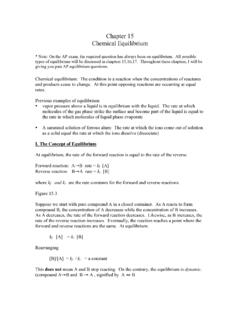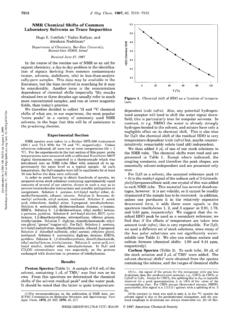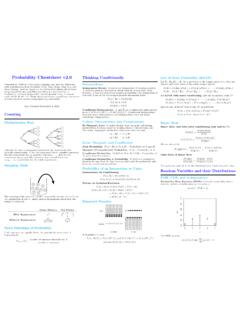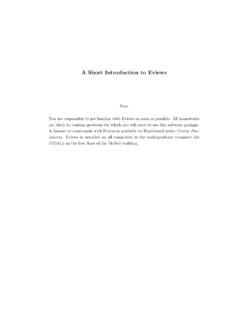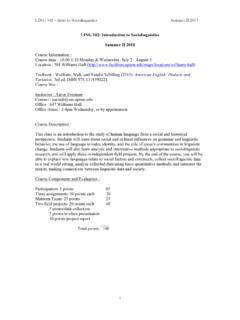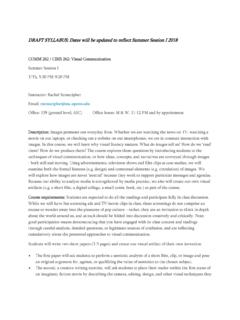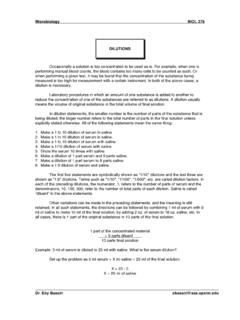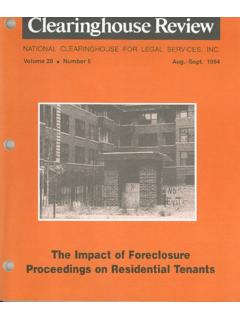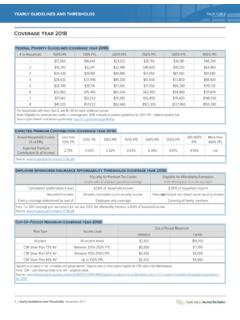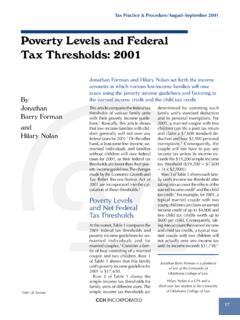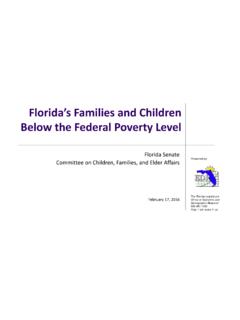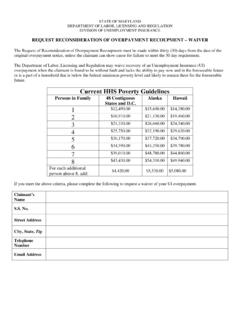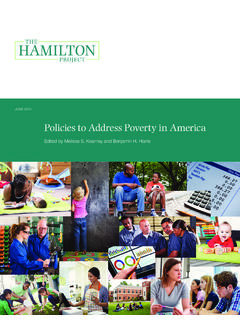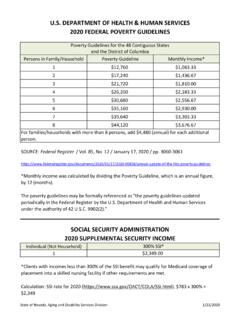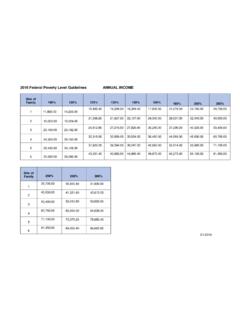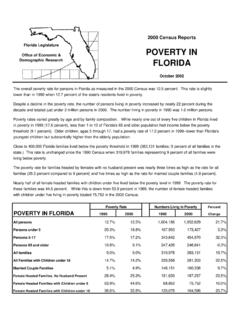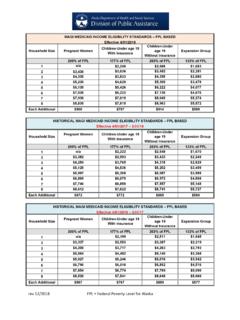Transcription of The Meaning and Measurement of Poverty
1 The Meaning and Measurement of Poverty : A Look into the Global Debate Mona Mowafi Table of Contents Income Poverty Absolute vs Relative Constructing the $1/Day Poverty Problems with the $1/Day Poverty Possible Human Poverty UNDP s Human Poverty Index (HPI)..11 Understanding Poverty Using the Adapting the HPI to Local Strengths and Weaknesses of the Sen s Capabilities Refining the HPI: Poverty as a Deficiency of Equality of What? Foundations of the Capabilities, Freedom, and Operationalizing the Capabilities Outstanding Participatory Approaches: Voices of the The Challenges to References 1 Introduction: Defining Poverty A Critical Debate We will spare no effort to free our fellow men, women, and children from the abject and dehumanizing conditions of extreme Poverty , to which more than a billion of them are currently subjected (MDG 2000).
2 In September 2000, the international community issued a bold statement pronouncing the eradication of Poverty as the number one development goal for the new millennium. Specifically, it set out to halve severe Poverty by the year 2015. Coinciding with this commitment, the World Bank (henceforth, Bank) focused its 2000/01 World Development Report on exploring best practices for reaching this goal, repositioning Poverty alleviation as the single greatest mission guiding the Bank s policies and programs. At such a juncture, one may have reasonably assumed that a yardstick had already been established for measuring the magnitude of the challenge ahead and for assessing progress in the years to come.
3 In fact, experts in the field have yet to agree upon a single definition of Poverty that can be used to measure the number of poor people globally in a way that is both valid and consistent. Therefore, while Poverty eradication has been named the primary challenge for the new millennium, how to measure and assess progress in this crucial area remains uncertain. This paper seeks to explore the main approaches to Poverty Measurement currently under consideration by the international community. Specifically, income Poverty , human Poverty , capabilities deprivation, and participatory approaches will be discussed, highlighting the advantages and drawbacks of each method.
4 For some twelve years, the Bank has calculated and published global estimates of the poor based on what is widely known as the $1/day Poverty line. While economists within the Bank argue that the numbers are accurate, a growing debate has emerged around the methodology employed to reach these estimates. As an institution whose main mission is Poverty reduction, the Bank has a unique role in ensuring that its published global count of the poor can be used to measure progress in this area. Often quoted for advocacy purposes and in formal Poverty research, addressing concerns regarding these estimates is of considerable practical significance. This paper will address the issues surrounding the Bank s current $1/day definition while paying particular attention to the alternatives that have been introduced to revise and update this measure for the purposes of establishing a universally consistent approach to measuring income Poverty .
5 2 Arguably, however, a more fundamental issue is whether income deprivation is the most appropriate yardstick to measure Poverty in the first place. It has become widely accepted among researchers that Poverty may be defined in many ways, and that lack of access to basic services such as health and education may ostensibly be a greater cause of Poverty and underdevelopment than income deprivation alone. Measures such as the Human Poverty Index (HPI) put forth by the United Nations Development Programme (UNDP) make an effort to address this issue and will be discussed as another potential method for measuring Poverty . Just as the debate over conventional approaches was gaining momentum in the late 90 s, economist Amartya Sen introduced a detailed and novel approach to understanding Poverty .
6 In his book Development as Freedom (Sen 1999), Sen shifts the conceptual framework by defining Poverty as a deprivation of human capabilities. Development, he asserts, is a function of people s ability to capitalize on their own capabilities as free human agents. To accomplish such a goal, people must be guaranteed essential rights and liberties. Therefore, Poverty may at its core be defined as a deprivation of human capabilities whose solution is the introduction of basic freedoms. In sum, Sen puts forth, freedom is both the ends and the means of development. The merits and details of Sen s capabilities approach will be thoroughly examined in this paper, along with counterpoints addressing the challenges to operationalizing such a definition of Poverty .
7 Finally, to round out the discussion of possible Poverty definitions, the paper will end where it began at the doorsteps of the World Bank. In an effort to address criticisms of being an outside-in actor a reputation gained throughout the 90s with its emphasis on structural adjustment policies that detracted from the priorities of the poor the Bank has revived its efforts to include the poor in the development process. To inform the WDR 2000/01, the Bank published a large-scale, albeit hurried, participatory study of what it means to be poor based on interviews with thousands of poor people in 47 countries around the world (Narayan 1999). Founded on the premise that the poor are the true Poverty experts, the Bank s Voices of the Poor study sought to draw connections and partnerships with the poor in order to include their perspectives in the process of developing a comprehensive, functional, and effective definition of Poverty .
8 What emerged was a multidimensional conception of Poverty , with income deprivation and food 3 insecurity joining powerlessness, social exclusion, and insufficient access to basic services as the most important factors describing their reality. This paper will look into each of these factors more explicitly and will discuss the issues surrounding the implementation of this definition. Income Poverty Measurements Absolute vs. Relative Poverty Like all statistical indicators, Poverty measurements are not just a technical matter but are also a reflection of the social concerns and values attached to the subject in question. What it means to be poor and who defines it is a topic that researchers and policymakers from a cross-section of disciplines have grappled with over many years.
9 In dealing with this issue, there are two broad concepts that have emerged: that of absolute Poverty and that of relative Poverty . While absolute Poverty refers to the set of resources a person must acquire in order to maintain a minimum standard of living, relative Poverty is concerned with how well off an individual is with respect to others in the same society. In theory, therefore, while an absolute Poverty line is a measure that could, adjusting for price fluxes, remain stable over time, a relative Poverty line is one that could be expected to shift with the overall standard of living in a given society. In reality, however, terms such as absolute are much less definitive than may seem suggested.
10 As far back as 1776, Adam Smith recognized the relativity of absolute measures by defining necessaries as not only the commodities which are indispensably necessary for the support of life, but whatever the custom of the country renders it indecent for credible people, even of the lowest order, to be without. More recently, Townsend (1992) defined economic Poverty as a deprivation of income that may enable people to play the roles, participate in the relationships, and follow the customary behavior which is expected of them by virtue of their membership in society. Surely, what is indecent or customary in society is much less objective a measure than what may, for example, be biologically necessary to maintain physical nourishment.
